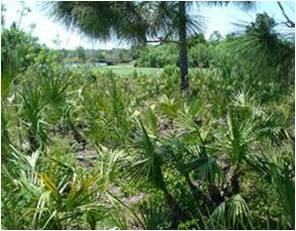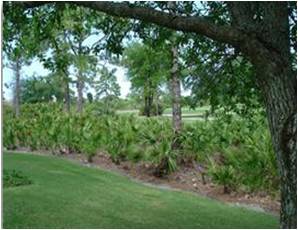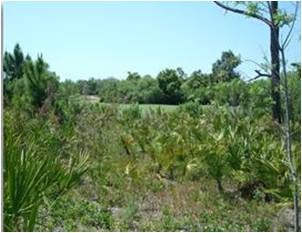 The conservation of indigenous
preserve areas is required by the Land Development Code. Large developments with existing indigenous native vegetation communities must provide 50 percent
of their open space requirement through the onsite preservation of existing
native vegetation communities.
The conservation of indigenous
preserve areas is required by the Land Development Code. Large developments with existing indigenous native vegetation communities must provide 50 percent
of their open space requirement through the onsite preservation of existing
native vegetation communities.
Pine flatwoods are fire-dependent
communities. They depend on natural wildfire to control the fuel loads of
accumulated vegetation in the understory and to control coverage and heights of
plants such as saw palmetto and perennials.
 Where plant communities are not
maintained naturally by fire, we must manage them manually. An Indigenous
Management Plan sets the guidelines for long-term maintenance of vegetation in
indigenous open space areas. It includes the method and frequency of
management, methods of exotic control, debris removal, protected species
management, and drafts of educational material provided to residents about the
purpose and function of the preserve.
Where plant communities are not
maintained naturally by fire, we must manage them manually. An Indigenous
Management Plan sets the guidelines for long-term maintenance of vegetation in
indigenous open space areas. It includes the method and frequency of
management, methods of exotic control, debris removal, protected species
management, and drafts of educational material provided to residents about the
purpose and function of the preserve.
Management plans are required to be
submitted with the development order for all developments approved after August
2005 to ensure the long-term management of preserves. However, developments
approved before August 2005 that want to manage their preserves can submit a
Retro Indigenous Management Plan for review.
Get the application. 
References:
Wade, Dale D., John J. Ewel, and
Ronald Harold. Hofstetter.
Fire in South Florida Ecosystems. Asheville,
NC: Southeastern Forest Experiment Station, 1980. Print.
Myers, Ronald L., and John J. Ewel.
Ecosystems of Florida. Orlando: University of Central Florida, 1990.
Print.